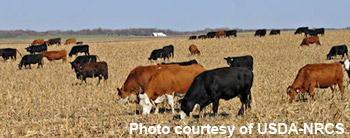February 2015
 The beef industry is a critical part of the agricultural economy for the state of Nebraska. With beef cow numbers at historic lows in the United States, cattle feeders and processors are aggressively competing for a limited supply of cattle. This scenario is encouraging producers to consider how they might grow the cow herd to meet this market demand.
The beef industry is a critical part of the agricultural economy for the state of Nebraska. With beef cow numbers at historic lows in the United States, cattle feeders and processors are aggressively competing for a limited supply of cattle. This scenario is encouraging producers to consider how they might grow the cow herd to meet this market demand.
One of the primary limiters in many people's minds to adding a beef cow enterprise in Nebraska is the tight supply of grass. Many acres of grass that were considered "tillable" were broke out and farmed during the last ten years to meet the market demand for grains.
This limited supply of grass combined with a relative abundance of crop residue provides a potential scenario for adding a beef cow enterprise in Nebraska that may be best suited to late summer/fall calving cows. The following are factors that contribute to this opportunity.
- Price of summer grass versus crop residue for grazing.
- Relative abundance and availability of crop residue versus grass for grazing.
- Availability and complementary value of by-products as a supplement to cow-calf pairs grazing crop residue.
- Accessibility of spring-calving cows that are late bred or open that could be moved to a fall-calving program.
- Ease of managing and hauling dry cows a long distance to summer grass versus cow-calf pairs.
- Approximately 2.5 fall calving cows could be summered on grass where currently two spring-calving cow-calf pairs are grazed.
- Simplicity of drylotting a late summer/fall calving cow in the spring and early summer as compared to a cow-calf pair.
- Market demand for 400-600 pound calves in the spring of the year.
- Potential reduced breeding expense from double use of bulls for spring- and fall-calving herds.
Fall-calving cows under today's available feed resources and market scenario may provide the greatest opportunity for Nebraska producers to add a beef cow enterprise or build onto an existing one. If you are thinking about starting or growing a cowherd, consider taking the time to sit down and put some numbers to it. Think creatively how late summer/fall calving cows might be made to work.
For many farming operations where grass is limited, confining cows for a portion of the year when crop residue isn't available for grazing may be a viable alternative to summer grass. Dr. Karla Jenkins and Dr. Rick Rasby recently wrote a NebGuide titled "Management Considerations for Beef Cows in Confinement" (PDF version, 667KB) that outlines things to consider when putting cows in a drylot situation.
Dr. Jenkins recently recorded a webinar "Confinement Cows Series, Part 1: Nutritional Considerations" that highlights keys for feeding beef cows and cow-calf pairs in confinement. This will be the first of a series of webinars that discusses management considerations for beef cows in confinement scenarios.
Aaron Berger
Extension Educator
Panhandle Research & Extension Center
University of Nebraska